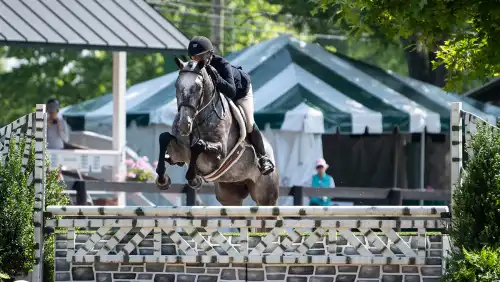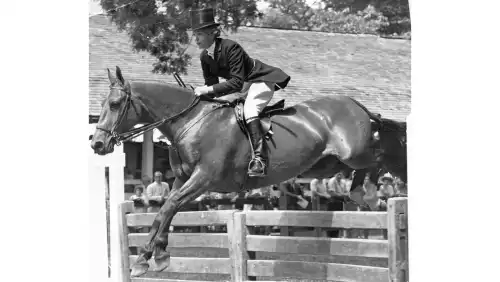After 30 years in the horse industry, our columnist sees changes that worry her.
What’s happened to our country? I know that’s a rhetorical question and one that has a myriad of answers, but I often wonder where our sport is heading. The problems I see in our world are mirrored in our culture as a whole—the obsession with instant gratification, the focus on short cuts and the shunning of tradition—these are paths I don’t want to see us following.
Apathy. I’ve written about apathy in prior articles. We’re lowering our standards, lowering our jumps, dropping our manners, dropping our loyalties—that’s the norm that I see now. I feel that instead of spending our time and energy trying to build things in a positive manner we’ve looked for the easy way out on so many fronts.
Life isn’t always comfortable, and the decisions we make sometimes affect many people. As George Morris said during his clinic at Buffalo Therapeutic Riding Center in Buffalo, N.Y., on Nov. 12-14, “We need to strive to better ourselves as trainers and riders. We need to want to be better and go outside our comfort zone–even if it’s for one lesson, one clinic or one class at a horse show.”
George’s clinics are amazing. I’m not quite sure why more people don’t take time out to ride or audit one of George’s clinics. He’s so dedicated to the basics, to good horsemanship and to the welfare of the horse. He spots the problems with each rider; he recognizes trends and poor riding habits so quickly. I feel so lucky as a trainer to host this clinic each year at my facility.
Why are we lowering the jumps? I’m using this question as a metaphor, but it’s where I see us heading. Many Americans seem to want the easy way out, so across the board we’re making our goals softer and easier.
We as trainers need to remember that to educate our children (and our adults!) in all aspects of horsemanship we need to set the bar higher. We need to provide support and encouragement while at the same time allowing them to prove themselves. If a student is uninterested in trying or learning, there should be consequences. We shouldn’t accommodate these students’ behaviors for fear of “damaging their psyches” as some would say. Trainers do need to have empathy and understanding, but if a student is to learn life’s lessons in and out of the barn, a trainer must be allowed to train, not just babysit.
A Dysfunctional Concept
The economy is definitely taking its toll on the horse business. When times are tough in the “real” world the horse industry is usually the last to feel it. We’ve survived each economic down time and learned valuable lessons along the way. But we cannot survive making rule after rule that legislates good riding.
That’s why raising the bar is so important. Good horsemanship and good riding should always be our No. 1 goals at every level.
I’ve seen a dysfunctional concept develop in our country—we’ve fallen into a habit of making divisions and levels at which all riders can win. We’re teaching our children (and our adults) that everyone is equal, and there are no winners and losers. We’re teaching people to ride down in potential, not to ride up.
ADVERTISEMENT
Even today’s course designers make the first jump lower in many classes. At the fall indoor shows this year the first year green fences looked like 3’3″, and now the jump cups are blamed: the new cups either make the jumps 3’5″ or 3’7″. I know the first choice is 3’5″.
As riders and trainers we’re supposed to be aspiring to the fall indoor shows, Devon (Pa.) and most AA-rated shows. Please make the jumps appropriate to the division height of 3’6″, 3’9″, 4′ to 4’3″.
I understand that the 3′ or 3’3″ divisions are important too and should be that height. But for those who wish to jump lower fences, there are thousands of schooling shows and lower-level competitions you can attend.
I’ve heard George lament for years about how our American system has been watered down, and that’s so sad. Now our top jumper riders have to go to Europe to prepare for the Olympic Games because we’re not setting courses in this country to prepare them for the highest levels of competition.
In other sports there are levels that you climb, by age and/or ability, from middle school to high school to college to professional or amateur. In the professional sports, the pay scale is reflective of your ability and the technique and the difficulty of the sport.
In the past, our sport was built upon these same structures. We always had steps that a student followed on his way up levels. From the first lessons, to leasing or buying a horse, to the first schooling show, then a local B- or C-rated show, then on to the A-rated and then AA-rated shows. But now we’re not following this path. We’re taking all of our riders to each show at the highest levels and showing in divisions that might or might not be appropriate.
There are many shows that offer stepping stones to the AA-rated shows, but often trainers skip these steps, for a variety of reasons. We should return to these “forgotten” steppingstones because when trainers place students in inappropriate divisions they’re perpetuating the problem.
No Simple Fixes
You can’t avoid good competition if you want to get better. It’s easy to blame someone else when you don’t do well. Unfortnately, in the hunter sections the judges are the first to be blamed. Most of the time the person criticizing isn’t a judge, isn’t watching the entire class, isn’t sitting in the same spot as the judges or has rose-colored glasses on while watching his horse’s performance.
ADVERTISEMENT
Most top professionals tell the owner or rider the truth about what happened in their horse’s round. But do the riders or owners want to hear the truth? Many people feel that if they’re spending their hard-earned money their opinion must be valued and the last word. Sometimes trainers do find great value in an owner’s thoughts and knowledge. But when a trainer is held responsible for all of the problems and contradicted by an owner, problems follow.
Sometimes horses have problems that don’t have an instant fix. So what’s the answer? Work harder and together to solve the problem? That’s what I hope to see, but unfortunately some people want the simple fix: a trainer change.
Let Them Be Amateurs
Today’s amateurs aren’t immune to the changing culture. Even if they grew up “back in the day” when horse shows were more sport than business, some of them have followed the trend toward gratification from ribbons rather than through progression and hard work. One of my pet peeves is to see amateurs, with nothing better to do, sitting on the rail criticizing their fellow amateurs—mostly the ones who win! What happened to supporting your fellow competitors, whether you win or lose? What would you think if the tables were turned?
Speaking of amateurs, the U.S. Equestrian Federation amateur rule has been abused by some people over the years—and thankfully it’s currently under revision—but there have always been amateurs who work hard and strive for success but who are true amateurs. I’m growing tired of hearing people bad-mouth these riders simply because they’re good riders.
I’m concerned about one rule change being considered for the amateur-owner division. The change would allow amateurs to show additional horses that they don’t own in non-amateur-owner divisions at the same show where they’re competing their own horses in the amateur-owner sections. (Yes, that’s confusing. You might need to read that sentence twice!)
The amateur-owner division has been one of our strongest divisions since its inception many, many years ago.
It’s comprised of people who work and show horses they own. This division has produced many top riders and
many top horses. In my eyes we’re now asking those riders to compete as professionals. Why?
As I write this column, I’m sitting in my office at the BTRC where we’re hosting the USHJA Emerging Athletes Program National Finals. Twelve of the top EAP riders from across the country are spending three days with Melanie Smith Taylor, Peter Wylde, Jennifer Alfano, Mindy Bower, Dr. Kit Miller and Dr. Midge Leitch.
Hosting this program has reminded me again where we’ve come from and where we’re going. I’m continually inspired whenever I watch these experts sharing their knowledge, and it’s especially gratifying to see the focused young people soaking up this horsemanship and striving to improve themselves. If these EAP riders continue to follow the examples set by such esteemed clinicians, I believe that good horsemanship, strong basics and a continual exchange of ideas will eventually win out and quell any apathy.
Susie Schoellkopf, of Buffalo, N.Y., is an active R-rated judge for hunters and equitation. She was a successful hunter rider and now is the owner and manager of SBS Farms, a training stable, as well as the executive director of the Buffalo Therapeutic Riding Center. She is a member of several U.S. Equestrian Federation committees and a founder of the Horsemen’s Advisory Council. Susie’s first Chronicle column was published in November 2002.















